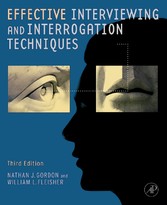Suchen und Finden
Service
Effective Interviewing and Interrogation Techniques
Nathan J. Gordon, William L. Fleisher
Verlag Elsevier Reference Monographs, 2010
ISBN 9780123819871 , 398 Seiten
3. Auflage
Format PDF, ePUB, OL
Kopierschutz DRM
Geräte
Front cover
1
Effective Interviewing and Interrogation Techniques
4
Copyright page
5
Contents
6
Foreword
8
Preface
10
About the Authors
12
Acknowledgments
14
Companion Web Site
15
Chapter 1: The Search for Truth
16
Summary
24
References
24
Chapter 2: Truth and Lies
26
Summary
30
Reference
30
Chapter 3: Psychophysiological Basis of the Forensic Assessment
32
Summary
41
References
41
Chapter 4: Preparation for the Interview/Interrogation
42
Summary
50
Reference
50
Chapter 5: Morgan Interview Theme Technique (MITT)
52
MITT Suspect 1
61
MITT Suspect 2
64
MITT Suspect 3
67
MITT Suspect 4
69
Summary
72
References
72
Chapter 6: Forensic Statement Analysis
74
Summary
102
References
102
Chapter 7: Question Formulation:
104
Irrelevant questions
104
Relevant questions
105
Comparison questions
107
Summary
110
References
110
Chapter 8: Projective Analysis of Unwitting Verbal Cues
112
Summary
119
References
119
Chapter 9: Nonverbal Behavioral Assessment
120
General posture
125
Head and face
129
Arms and hands
138
Feet and legs
142
Grooming behaviors
142
Thinking gestures
143
Involuntary biological signs
144
Paralinguistic behaviors
145
Neurolinguistics
145
Nonverbal behavior during the interrogation; surrender
153
Summary
154
References
154
Chapter 10: Traditional Scoring of the Faint Interview
156
Case study 1
159
Case study 2
160
Suspect A
162
Suspect B
165
Case study 3: multiple suspects
167
Summary
181
Chapter 11: The Validation of the Forensic Assessment Interview (Faint)
182
Case study 1
202
Case study 2
205
Case study 3
209
Case study 4
213
Case study 5
216
Case study 6
220
Summary
223
References
223
Chapter 12: Interviewing Children and the Mentally Challenged
224
Summary
233
References
233
Chapter 13: Report Writing
234
Summary
236
Chapter 14: Torture and False Confessions:
238
Summary
247
References
247
Chapter 15: Pre-employment Interviewing
248
Summary
253
References
253
Chapter 16: Passenger Screening with Verbal and Nonverbal Cues
254
Summary
260
References
260
Chapter 17: Legal Considerations
262
Summary
267
References
268
Chapter 18: The Integrated Interrogation Technique
270
1. Make a forceful assertion that the suspect is guilty
272
2. Do not allow the suspect to deny the act
273
3. Offer a series of possibilities of how and why this may have happened
273
4. Undermine the person's self-confidence
274
5. Offer persuasive arguments for telling the truth
275
6. Offer solutions, where possible, to alleviate the person's fear
275
7. Compliment the person
275
8. Use alternative and leading questions
276
9. Watch for the "buy" signs
277
10. Move in close and press for the confession
277
Summary
292
Reference
292
Chapter 19: Statements, Recordings, and Videos
294
Summary
297
References
297
Chapter 20: Understanding Aggressive Behavior and Dealing with Angry People
298
Intention movements of attack
306
Vacuum gestures
307
Redirection gestures
307
Preattack warning signs
309
Summary
310
Chapter 21: The Instrumental Detection of Deception: Polygraph
312
Summary
325
References
326
Chapter 22: The Search for Truth:
328
Summary
337
References
338
Appendix A: Forensic Assessment Interview
340
Appendix B: Weighted Faint Form: Forensic Assessment Interview
348
Appendix C: Pre-employment Booklet (KeystoneIntelligence Network, Inc.)
356
Appendix D: Questionnaire
374
Index
384
Service
Shop



















